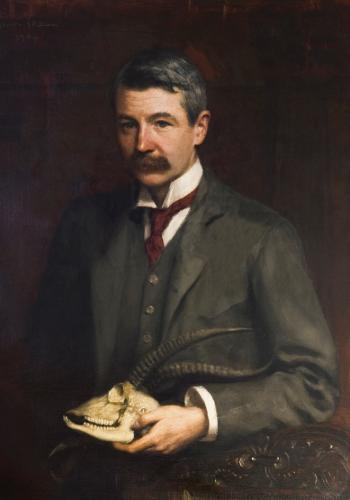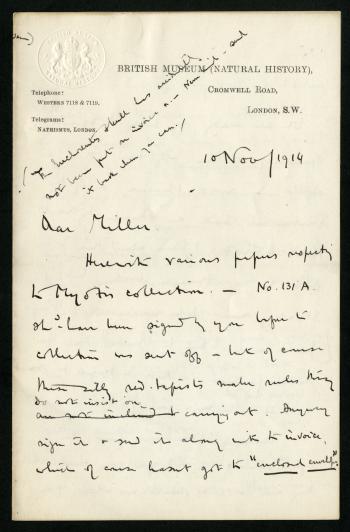 Born in 1858, Michael Rogers Oldfield Thomas began working at London’s Natural History Museum at the age of 18. Within ten years, he had taken charge of the museum’s vast collection of Mammalia and by the end of his career he had described thousands of species, laying a broad foundation for later developments in the field of zoology. As one historian notes, Thomas ranked among the “greatest taxonomists who had ever lived.” His efforts were recognized with appointments to the Royal Society of London and the Royal Geographical Society the Zoological Society of London.
Born in 1858, Michael Rogers Oldfield Thomas began working at London’s Natural History Museum at the age of 18. Within ten years, he had taken charge of the museum’s vast collection of Mammalia and by the end of his career he had described thousands of species, laying a broad foundation for later developments in the field of zoology. As one historian notes, Thomas ranked among the “greatest taxonomists who had ever lived.” His efforts were recognized with appointments to the Royal Society of London and the Royal Geographical Society the Zoological Society of London.
Oldfield Thomas rose to his position as one of the world’s foremost taxonomists following his marriage to Mary Kane, a wealthy heiress. Her money gave him the resources necessary to send research assistants to the far-flung corners of the British Empire collecting specimens from Natal to Calcutta and from Tasmania to Jamaica. Thomas found it difficult to separate his scientific endeavors from Britain’s imperial reach. In a 1924 letter to Gerrit Smith Miller (Curator of Mammals at what is now the National Museum of Natural History, from 1909-1940), he used the language of imperial expansion and colonization to celebrate the progress of his research. Likening his endeavor to a map of the world, he wrote: “You and I in our scientific lives have seen the general knowledge of Mammals of the world wonderfully advanced – there are few or no blank areas anymore.” Both Thomas and Miller stood as prominent citizens of this empire of science.
Another letter to Miller described a dispute with the zoologist Austin Roberts of the Transvaal Museum (now the Ditsong National Museum of Natural History) in Pretoria, South Africa. Thomas urged Miller to pick sides, adding that the Transvaal Museum had always been “under Boer auspices, and it is still anti-British.” This bitter reference to the Boer War, which resulted in the establishment of the Union of South Africa in 1910, suggests that this disagreement was not solely scientific. Thomas’s anger over Boer independence clearly influenced his intellectual exchanges with Roberts.


In times of war, geopolitical boundaries threatened the scientific endeavor itself. Four months into World War I, Thomas and Miller were attempting to finish cataloging the Myotis collections held by both the Smithsonian and London’s Natural History Museum. Before sending the collection across the Atlantic, Thomas took care to divide them into several shipments, reasoning that “if the barbarians sink one steamer they won’t spoil the rest.” He also sent them on American ships, hoping that American neutrality would minimize the danger of having them destroyed by German U-boats. This neutrality cut both ways, though. The exchange of scientific papers between Thomas and Miller was routinely interrupted by a censor’s suspicions over “matter intended for publication in a neutral country.” Under the Defence of the Realm Act, passed just four days following the outbreak of hostilities with Germany, British censors were empowered to halt the dissemination of any material injurious to the war effort. And, esoteric scientific papers immediately fell under suspicion. However, once the United States entered the war, the embargo was lifted.
Stretching the canvas of scientific endeavor across the frame of empire allowed Oldfield and Miller to cover a vast body of knowledge that was foundational to modern biology. Over the twentieth century, both WWI and a variety of colonial independence movements would shake that foundation, revealing the tension between and imperial vision of science and a utopian vision of science as a fundamentally humanist enterprise that could transcend the boundaries of nation, empire and ideology. The legacy of Thomas and his contemporaries would survive the British Empire and contribute significantly to the development of the biological sciences. Though empires fall, science endures.
Related Collections
Gerrit Smith Miller, Jr., Papers, 1908-1940, Smithsonian Institution Archives
Produced by the Smithsonian Institution Archives. For copyright questions, please see the Terms of Use.

Leave a Comment